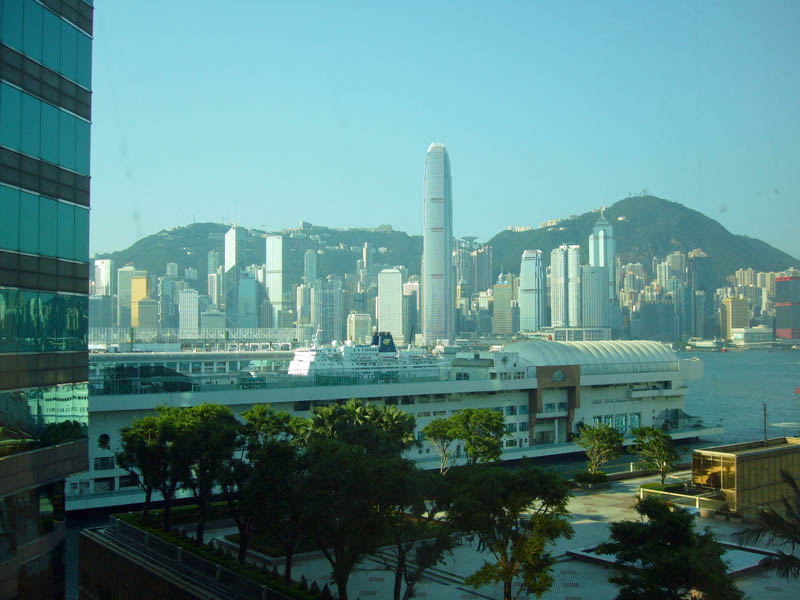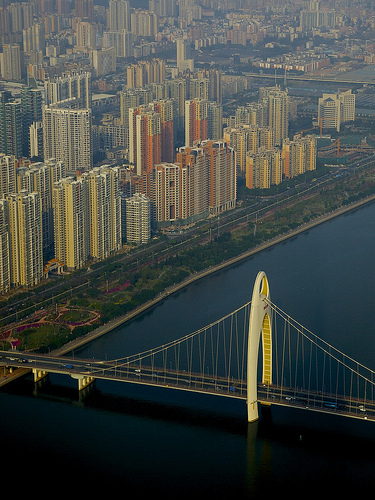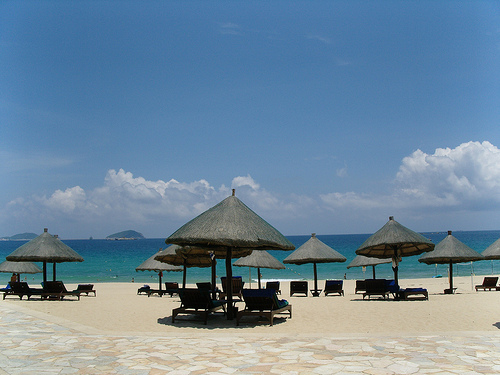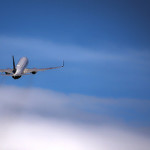Obtaining a Chinese visa, or any visa for that matter, can be a pain in the butt and expensive. It’s currently $140 for a Chinese visa and the requirements for submitting an application can be tedious.
For years, it’s been possible to travel to Hong Kong and Macau without a visa, but traveling to mainland China without a visa has been a different story.
However, as of 2013, there are several ways you can travel to China without a visa.
For clarification purposes regarding the title of this article, you still technically need a visa to enter China. However, rather than having to apply for a visa beforehand and spending the $140, the methods outlined below allow you to obtain a Chinese transit visa upon landing and these options are all free.
72-hour Transit Visa
At certain airports in China, if you have an onward ticket to another destination, you can take advantage of a 72-hour transit visa. For example, if you’re flying from Los Angeles to Bangkok via Beijing, you can stay in Beijing for up to 72-hours before heading to Bangkok. You don’t need to apply for a visa beforehand. When you check-in to your airline in Los Angeles, inform the airline of your intention so they can declare your request to the airport customs before landing.
In addition to Beijing, there are 17 other airports that currently honor the 72-hour transit visa. There are typically signs in the Chinese airports directing you to the 72-hour transit visa location, so if you don’t see that just ask around.
We’ll get to those other locations in a minute, but one thing to understand is that you can’t just waltz in to China and expect to be handed a 72-hour transit visa. There are strict guidelines for obtaining this visa, and it’s important to know them so you don’t embarrass yourself, or worse:
- As it stands right now, travelers from only 51 qualified countries can take advantage of this transit visa. To see if your country is listed, check here.
- As mentioned earlier, you can only get this visa if you are traveling to another country (also called a 3rd region) after China, not including the country you just came from. In other words, this won’t work if you fly from Los Angeles-Beijing-Los Angeles.
- Along the same lines as the previous item, transiting within China is not permitted either. So Los Angeles-Beijing-Chengdu does not qualify you for a 72-hour transit visa in Beijing. In this case you’d have to apply for an actual visa prior to traveling. Implied here is that you must enter and exit China from the same airport (exception: the Shanghai-Zhejiang-Jiangsu triangle…more on these areas in the section on the 144-hour visa).
- Hong Kong, Macau, and Taiwan are all considered 3rd regions, so if you’re continuing on to one of these 3 locations, you may obtain a 72-hour visa on mainland China.
What documents do you need to show?
If you meet the qualifications listed above, there’s a good chance you’ll be able to get a 72-hour visa. Just make sure you have the following documents with you because they will be checked:
- Passport
- Visa for follow-on country, if applicable. If you’re traveling on to Cambodia, for example, you’ll need to show that you have a valid visa for Cambodia. If you’re traveling to Thailand, you won’t need to show anything because a visa for Thailand is not required if staying under 30 days.
- A fully completed arrival/departure card
- Onward ticket with seat confirmation
When do my 72 hours start?
The clock starts ticking on your 72 hours at midnight the day after you arrive. For example, if you arrive early in the morning on Jan 1, the clock starts ticking at midnight on Jan 2. Therefore, you have until 11:59pm on Jan 4 to return.
Having said that, the duration of your stay should be part of the stamp you get at immigration, so confirm this information before leaving the immigration desk. The last thing you want to do is violate the terms of the transit visa over a misunderstanding of time.
Step-by-step procedure
From the time you check your luggage in at your departure airport to the time you leave the airport in China, here is a step-by-step breakdown of the 72-hour visa process:
- Inform the airline you’re flying with of your intention to obtain a 72-hour visa. This can be done at luggage drop-off or at the boarding gate.
- Fill out your arrival/departure card on the flight. Once you inform your airline of your intention they’ll either give you the card at the airport or on the flight.
- When you arrive in China, follow the signs for 72-hour visa processing or find someone that can direct you there.
- Apply for the visa in person.
- Once approved, confirm the information on the stamp, to include the date you need to be back at the airport.
- Pick up luggage.
- Clear customs.
- Within the first 24 hours, register with the police at a nearby police station. Failure to do this could result in a fine or deportation. If you’re staying at a hotel, they will do this for you when you check in, but if you’re staying at a residence, you’ll have to do this yourself. Also, Chinese law requires that you carry your valid passport and Chinese visa or residence permit at all times. In all honesty, I’m not aware of how strictly these policies are enforced, but I wouldn’t take any chances. If you have any personal experience, please leave it in the comments below.
72-hour Visa Airports
| Airports (with airport code) | Areas allowed to stay |
|---|---|
| Guangzhou (CAN) Chengdu (CTU) Qingdao (TAO) Changsha (CSX) | Allowed to travel in the whole province. |
| Beijing (PEK) Chongqing (CKG) Harbin (HRB) Guilin (KWL) Kunming (KMG) Wuhan (WUH) Xiamen (XMN) Tianjin (TSN) | Cannot leave the administrative area for each of these cities. |
| Shanghai (PVG) Zhejiang-Huangzhou (HGH) Jiangsu-Nanjing (NKG) | Allowed to move around between Shanghai, Zhejiang, and Jiangsu. |
| Dalian (DLC) Shenyang (SHE) | Allowed to travel within these two cities. |
| Xian (XIY) | Allowed to travel in the administrative areas of Xian and Xianyang |
For more information on the 72-hour visa, here are a couple helpful resources:
144-hour Transit Visa
The implementation of the 72-hour visa in 2013 was so popular that China decided to adopt a 144-hour (6 day) transit visa policy in 2016 for the Shanghai area.
The 144-hour transit visa applies to the same 51 countries and the qualification rules remain the same. Remember from the 72-hour transit visa that you can only obtain them at specific airports in China. One major difference for the 144-hour visa is that Shanghai has multiple ports of entry that are eligible for a transit visa. Also, you can travel in and between Shanghai, Zhejiang, and Jiangsu. Here are the eligible ports of entry for the 144-hour transit visa:
- Zhejiang: Hangzhou Airport (HGH)
- Jiangsu: Nanjing Airport (NKG)
- Shanghai: Pudong Airport (PVG) and Hongqiao Airport (SHA), Shanghai Port International Cruise Terminal, Wusong Passenger Transport Center and all railway stations in Shanghai.
Again, you should see signs directing you to the 144-hour transit visa section. If not, just ask.
You can find more info on the 144-hour transit visa at China Travel Guide.
In fact, if you’re not sure what to do with 6 whole days in that region, China Travel Guide has put together a sample itinerary to give you some ideas.
Other Visa Exemptions
Hong Kong and Macau
For US citizens, a visa is not required if traveling to Hong Kong and/or Macau. For Hong Kong, you can stay for up to 90 days without a visa; for Macau, it’s 30 days. Be sure to check the Chinese Embassy website for any changes or updates.
For non-US citizens, check the Hong Kong SAR Immigration Department and the Macau SAR Public Security Police Force to see visa requirements.
Visiting the Pearl River Delta or Hainan Island
Hong Kong and Macau are both considered part of the Pearl River Delta in southern China. There are also a few major destinations on mainland China, including Guangzhou, Shenzhen, and Kaiping, that are part of the Pearl River Delta.
Normally you would need a visa to travel to the latter destinations. However, if you are already in Hong Kong or Macau and you join a travel group from a registered travel agency, you can visit mainland China destinations in the Pearl River Delta without a visa for up to 6 days. This applies to visitors from all countries that have diplomatic relations with China.
Similarly, if you plan on visiting Hainan Island (considered to be mainland China), you can visit for up to 15 days without a visa. Unlike the Pearl River Delta region, though, visiting Hainan without a visa is limited to passport holders of certain countries. Also, you must join a tour group of at least 5 people that is organized by an international travel agency registered in Hainan with the approval of China National Tourism Administration. That’s a mouthful.
Those countries allowed to visit Hainan without a visa are: Australia, Austria, Canada, Denmark, Finland, France, Germany, Indonesia, Italy, Japan, Kazakhstan, Malaysia, Netherlands, New Zealand, Norway, Philippines, Russia, Singapore, South Korea, Spain, Sweden, Switzerland, Thailand, Ukraine, United Kingdom, and United States. For Germany, South Korea, and Russia, you can stay up to 21 days and your tour group can be as small as 2 people.
There are a couple other ways to enter China without a visa, but they are mainly for business or diplomatic purposes. For a full list of visa exemptions in China, click here.
Summary
For those wanting to travel to China without the hassle and expense of a Chinese visa, it is definitely doable. Granted, there are strict requirements, but much less strict than in years past.
To recap, these are the primary ways you can travel to China without a visa:
- 72-hour transit visa for various Chinese cities
- 144-hour transit visa for the Shanghai area only
- Visiting Hong Kong and Macau
- Visiting the Pearl River Delta region from Hong Kong or Macau
- Visiting Hainan Island (available to a limited number of countries)
If anyone has personal accounts from any of the methods described above, leave them in the comments section!









Do you have to pick up your luggage or can you leave it at the airport and just expect it to be on your connecting flight?
You will have to pick up your luggage, go through customs, and then re-check it before your next flight. This is one of the reasons it’s important to let the airline agent know about your 72 hour visa intention at your airport of origin. If you don’t feel like lugging it around in China, maybe check to see if the airport you’re flying in to has any luggage lockers, but I wouldn’t bank on this.